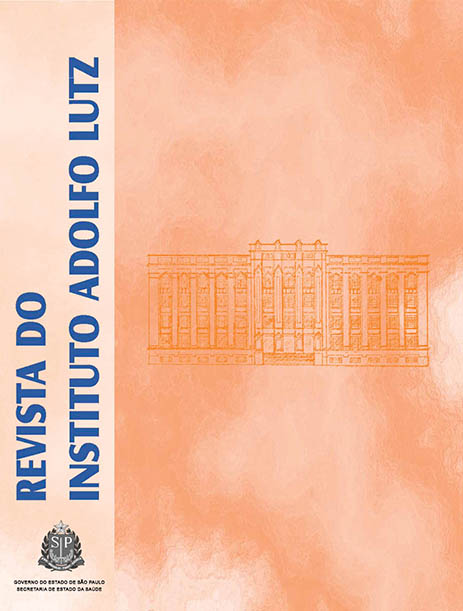Abstract
The protozoan parasite Cryptosporidium has emerged as one of the most important water contaminants, causing outbreaks of waterborne diarrhea worldwide. In order to assess the importance for public health of this pathogen’s presence in environmental samples, several methods have been developed to isolate and detect Cryptosporidium oocysts. In the present study, a reliable and reproducible method has been standardized for detecting and identifying Cryptosporidium oocysts in water samples in the State of São Paulo, Brazil as the first step for future genotyping studies. Water samples were concentrated by filtration, and then subjected to ultrasound in Tween 80 0.1%, the obtained sediment was transferred into micro tubes containing 1.0 ml of distilled water and stored at -20ºC. DNA was extracted with the addition of 1% PVP in lysis buffer, the organic extraction was performed in Phase Lock Gel Heavy®. There was a 214 bp amplification on the expected fragment in five out of the 11 water samples analyzed. The results of this study demonstrated the application usefulness of the standardized test in epidemiological studies and surveillance programs because the technology allowed to increase significantly the amount of amplified product.References
1. Franco RM, Rocha-Eberhardt R, Cantusio Neto R. Occurrence of Cryptosporidium oocysts and Giardia cysts in raw water from the Atibaia River, Campinas, Brazil. Rev Inst Med Trop S. Paulo. 2001;43:109-11.
2. Hachich EM, Sato MI, Galvani AT, Menegon JR, Mucci JL. Giardia and Cryptosporidium in source waters of São Paulo State, Brazil. Water Sci Technol. 2004;50:239-45.
3. Cantusio Neto R, Santos JU, Franco RM. Evaluation of activated sludge treatment and the efficiency of the disinfection of Giardiaspecies cysts and Cryptosporidium oocysts by UV at a sludge treatment plant in Campinas, South-east Brazil. Water Sci Technol. 2006;54:89 - 94.
4. Santos LU, Bonatti TR, Cantusio Neto R, Franco RM. Occurrence of Giardia cysts and Cryptosporidium oocysts in activated sludge samples in Campinas (SP), Brazil. Rev Inst Med Trop S. Paulo. 2004;46:309-13.
5. Farias E, Coutinho W, Gamba RC, Pellizari VH. Detection of Cryptosporidium spp. Oocysts in raw sewage and creek water in the city of Sao Paulo, Brazil. Braz J Microbiol. 2002;33:41-3.
6. Franco RM, Cantusio Neto R. Occurrence of cryptosporidial oocysts and giardia cysts in bottled mineral water commercialized in the city of Campinas, State of São Paulo, Brazil. Mem Inst Oswaldo Cruz. 2002;97:205-7.
7. Gonçalves EM, da Silva AJ, Eduardo MB, Uemura IH, Moura IN, Castilho VL, et al. Multilocus genotyping of Cryptosporidium hominis associated with diarrhea outbreak in a day care unit in São Paulo. Clinics. 2006;61:119-26.
8. Carvalho-Almeida TT, Pinto PLS, Quadros CMS, Torres DMAGV, Kanamura HY, Casimiro AM. Detection of Cryptosporidium sp in non diarrheal faeces from children, in a day care center in the city of Sao Paulo, Brazil. Rev Inst Med Trop S. Paulo. 2006;48:27- 32.
9. Carvalho-Almeida TT, Casimiro AM, Matté GR, Matté MH. An improved method for extracting Cryptosporidium sp. DNA from preserved faeces and potential application for cryptosporidiosis surveillance. REVISA. 2005;1:208-14.
10. Coupe S, Sarfati C, Hamane S, Derouin F. Detection of Cryptosporidium and identification to the species level by Nested PCR and restriction fragment length polymorphism. J Clin Microbiol. 2005;43:1017-23.
11. Coupe S, Delabre K, Pouillot R, Houdart S, Santillana-Hayat M, Derouin F. Detection of Cryptosporidium, Giardia and Enterocytozoon bieneusi in surface water, including recreational areas: a one year prospective study. FEMS Immunol Med Microbiol. 2006; 47:351-9.
12. Nichols RAB, Campbell BM, Smith HV. Molecular fingerprint of Cryptosporidium oocysts isolated during water monitoring. Appl Environ Microbiol. 2006;72:5428-35.

This work is licensed under a Creative Commons Attribution 4.0 International License.
Copyright (c) 2010 Instituto Adolfo Lutz Journal
